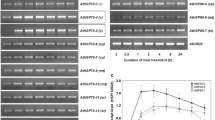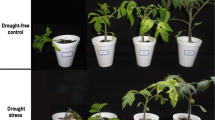Abstract
Members of the HSP70 family function as molecular chaperones to maintain cellular homeostasis and help plants cope with environmental stimuli. However, due to functional redundancy and lack of effective chemical inhibitors, our knowledge of functions of individual HSP70s has remained limited. Here, we confirmed a subclass of HSP70s, including HSP70-1, -2, -3, -4, and -5, localized to the cytosol and nucleus in Arabidopsis thaliana. Histochemical analyses of promoter:GUS reporter lines showed that HSP70-1, -2, -3, and -4 genes were widely expressed, but HSP70-5 was not. In addition, individual HSP70 showed not only similar but also distinct transcriptions when treated by different abiotic stresses and phytohormones. No apparent phenotype was observed when individual HSP70 genes were overexpressed or knocked-out/down, but the double mutant hsp70-1 hsp70-4 and triple mutant hsp70-2 hsp70-4 hsp70-5 plants exhibited developmental phenotypes with shortened specific growth periods, curly and round leaves, twisted petioles, thin stems, and short siliques. Moreover, both mutants were hypersensitive to heat, cold, high glucose, salt and osmotic stress, but hyposensitive to abscisic acid. Genes related to flowering, and the cytokinin, brassinosteroid, and abscisic acid signaling pathways were differentially expressed in both mutants. Our studies suggest that, the individual HSP70 possibly performs both redundant and specific functions with the other members in the cytosolic/nuclear HSP70 subclass, and apart from enabling plants to cope with abiotic stresses, this subclass of cytosolic/nuclear HSP70 proteins also participates in diverse developmental processes and signaling pathways.









Similar content being viewed by others
References
Alonso JM, Stepanova AN, Leisse TJ, Kim CJ, Chen H, Shinn P, Stevenson DK, Zimmerman J, Barajas P, Cheuk R (2003) Genome-wide insertional mutagenesis of Arabidopsis thaliana. Science 301:653–657
Aparicio F, Thomas CL, Lederer C, Niu Y, Wang D, Maule AJ (2005) Virus induction of heat shock protein 70 reflects a general response to protein accumulation in the plant cytosol. Plant Physiol 138:529–536
Banerjee A, Roychoudhury A (2015) Abscisic-acid-dependent basic leucine zipper (bZIP) transcription factors in plant abiotic stress. Protoplasma:1–14
Boorstein WR, Ziegelhoffer T, Craig EA (1994) Molecular evolution of the HSP70 multigene family. J Mol Evol 38:1–17
Boss PK, Bastow RM, Mylne JS, Dean C (2004) Multiple pathways in the decision to flower: enabling, promoting, and resetting. Plant Cell 16:S18–S31
Cazalé A-C, Clément M, Chiarenza S, Roncato M-A, Pochon N, Creff A, Marin E, Leonhardt N, Noël LD (2009) Altered expression of cytosolic/nuclear HSC70-1 molecular chaperone affects development and abiotic stress tolerance in Arabidopsis thaliana. J Exp Bot 60:2653–2664
Clément M, Leonhardt N, Droillard M-J, Reiter I, Montillet J-L, Genty B, Laurière C, Nussaume L, Noël LD (2011) The cytosolic/nuclear HSC70 and HSP90 molecular chaperones are important for stomatal closure and modulate abscisic acid-dependent physiological responses in Arabidopsis. Plant Physiol 156:1481–1492
Clough SJ, Bent AF (1998) Floral dip: a simplified method for Agrobacterium-mediated transformation of Arabidopsis thaliana. Plant J 16:735–743
Gupta RS, Golding GB (1993) Evolution of HSP70 gene and its implications regarding relationships between archaebacteria, eubacteria, and eukaryotes. J Mol Evol 37:573–582
Hwang I, Sheen J, Müller B (2012) Cytokinin signaling networks. Annu Rev Plant Biol 63:353–380
Jackson-Constan D, Keegstra K (2001) Arabidopsis genes encoding components of the chloroplastic protein import apparatus. Plant Physiol 125:1567–1576
Koizumi N (1996) Isolation and responses to stress of a gene that encodes a luminal binding protein in Arabidopsis thaliana. Plant Cell Physiol 37:862–865
Latijnhouwers M, Xu X-M, Møller SG (2010) Arabidopsis stromal 70-kDa heat shock proteins are essential for chloroplast development. Planta 232:567–578
Lee S, Tsai F (2005) Molecular chaperones in protein quality control. J Biochem Mol Biol 38:259–265
Lee S, Lee DW, Lee Y, Mayer U, Stierhof Y-D, Lee S, Jürgens G, Hwang I (2009) Heat shock protein cognate 70-4 and an E3 ubiquitin ligase, CHIP, mediate plastid-destined precursor degradation through the ubiquitin-26S proteasome system in Arabidopsis. Plant Cell 21:3984–4001
Lee JH, Jung JH, Park CM (2015) INDUCER OF CBF EXPRESSION 1 integrates cold signals into FLOWERING LOCUS C-mediated flowering pathways in Arabidopsis. Plant J 84:29–40
Lin B-L, Wang J-S, Liu H-C, Chen R-W, Meyer Y, Barakat A, Delseny M (2001) Genomic analysis of the Hsp70 superfamily in Arabidopsis thaliana. Cell Stress Chaperon 6:201
Maikova A, Zhanneta, Zalutskaya, Lapina T, Ermilova E (2016) The HSP70 chaperone machines of Chlamydomonas are induced by cold stress. J Plant Physiol 204:85–91
Maruyama D, Sugiyama T, Endo T, Nishikawa S-i (2014) Multiple BiP genes of Arabidopsis thaliana are required for male gametogenesis and pollen competitiveness. Plant Cell Physiol 55:801–810
Maruyama D, Endo T, Nishikawa S-i (2015) BiP3 supports the early stages of female gametogenesis in the absence of BiP1 and BiP2 in Arabidopsis thaliana. Plant Signal Behav 10:e1035853
Masand S, Yadav SK (2015) Overexpression of MuHSP70 gene from Macrotyloma uniflorum confers multiple abiotic stress tolerance in transgenic Arabidopsis thaliana. Mol Biol Rep 43:1–12
Mayer M, Bukau B (2005) Hsp70 chaperones: cellular functions and molecular mechanism. Cell Mol Life Sci 62:670–684
Medina J, Catalá R, Salinas J (2011) The CBFs: three Arabidopsis transcription factors to cold acclimate. Plant Sci 180:3–11
Noël LD, Cagna G, Stuttmann J, Wirthmüller L, Betsuyaku S, Witte C-P, Bhat R, Pochon N, Colby T, Parker JE (2007) Interaction between SGT1 and cytosolic/nuclear HSC70 chaperones regulates Arabidopsis immune responses. Plant Cell 19:4061–4076
Noguchi T, Fujioka S, Takatsuto S, Sakurai A, Yoshida S, Li J, Chory J (1999) Arabidopsis det2 is defective in the conversion of (24R)-24-methylcholest-4-en-3-one to (24R)-24-methyl-5α-cholestan-3-one in brassinosteroid biosynthesis. Plant Physiol 120:833–840
Park MY, Kim SY (2014) The Arabidopsis J protein AtJ1 is essential for seedling growth, flowering time control and ABA response. Plant Cell Physiol 55:2152–2163
Putterill J, Laurie R, Macknight R (2004) It’s time to flower: the genetic control of flowering time. Bioessays 26:363–373
Ritossa F (1962) A new puffing pattern induced by temperature shock and DNP in Drosophila. Experientia 18:571–573
Srivastava R, Deng Y, Shah S, Rao AG, Howell SH (2013) BINDING PROTEIN is a master regulator of the endoplasmic reticulum stress sensor/transducer bZIP28 in Arabidopsis. Plant Cell 25:1416–1429
Su P-H, Li H-m (2008) Arabidopsis stromal 70-kD heat shock proteins are essential for plant development and important for thermotolerance of germinating seeds. Plant Physiol 146:1231–1241
Su P-H, Li H-m (2010) Stromal Hsp70 is important for protein translocation into pea and Arabidopsis chloroplasts. Plant Cell 22:1516–1531
Sung DY, Guy CL (2003) Physiological and molecular assessment of altered expression of Hsc70-1 in Arabidopsis. Evidence for pleiotropic consequences. Plant Physiol 132:979–987
Sung DY, Kaplan F, Guy CL (2001a) Plant Hsp70 molecular chaperones: protein structure, gene family, expression and function. Physiol Plant 113:443–451
Sung DY, Vierling E, Guy CL (2001b) Comprehensive expression profile analysis of the Arabidopsis Hsp70 gene family. Plant Physiol 126:789–800
Tang T, Yu A, Ping L, Hong Y, Liu G, Li L (2016) Sequence analysis of the Hsp70 family in moss and evaluation of their functions in abiotic stress responses. Sci Rep 6:33650
Tian Q, Uhlir NJ, Reed JW (2002) Arabidopsis SHY2/IAA3 inhibits auxin-regulated gene expression. Plant Cell 14:301–319
Vierling E (1991) The roles of heat shock proteins in plants. Annu Rev Plant Biol 42:579–620
Wang X, Yan B, Min S, Wei Z, Zekria D, Wang H, Kai G (2015) Overexpression of a Brassica campestris HSP70 in tobacco confers enhanced tolerance to heat stress. Protoplasma 253:1–9
Werner T, Motyka V, Laucou V, Smets R, Van Onckelen H, Schmülling T (2003) Cytokinin-deficient transgenic Arabidopsis plants show multiple developmental alterations indicating opposite functions of cytokinins in the regulation of shoot and root meristem activity. Plant Cell 15:2532–2550
Wu S-H, Wang C, Chen J, Lin B-L (1994) Isolation of a cDNA encoding a 70 kDa heat-shock cognate protein expressed in vegetative tissues of Arabidopsis thaliana. Plant Mol Biol 25:577–583
Yang C, Liu J, Dong X, Cai Z, Tian W, Wang X (2014) Short-term and continuing stresses differentially interplay with multiple hormones to regulate plant survival and growth. Mol Plant 7:841–855
Yer EN, Baloglu MC, Ziplar UT, Ayan S, Unver T (2016) Drought-responsive Hsp70 gene analysis in Populus at genome-wide level. Plant Mol Biol Rep 34:483–500
Yin Y, Wang Z-Y, Mora-Garcia S, Li J, Yoshida S, Asami T, Chory J (2002) BES1 accumulates in the nucleus in response to brassinosteroids to regulate gene expression and promote stem elongation. Cell 109:181–191
Yu X, Li L, Zola J, Aluru M, Ye H, Foudree A, Guo H, Anderson S, Aluru S, Liu P (2011) A brassinosteroid transcriptional network revealed by genome-wide identification of BESI target genes in Arabidopsis thaliana. Plant J 65:634–646
Zhang X-P, Glaser E (2002) Interaction of plant mitochondrial and chloroplast signal peptides with the Hsp70 molecular chaperone. Trends Plant Sci 7:14–21
Acknowledgements
We are grateful to the Arabidopsis Biological Resource Center at Ohio State University for providing T-DNA insertion mutants. We are also thankful for help from Mengran Yang and Yangbin Gao in scientific writing. This work was supported by the National Basic Research Program of China (Grant Number 31371231 to W.S.).
Author information
Authors and Affiliations
Corresponding author
Additional information
L. Leng and Q. Liang contributed equally to this work.
Electronic supplementary material
Below is the link to the electronic supplementary material.
Rights and permissions
About this article
Cite this article
Leng, L., Liang, Q., Jiang, J. et al. A subclass of HSP70s regulate development and abiotic stress responses in Arabidopsis thaliana . J Plant Res 130, 349–363 (2017). https://doi.org/10.1007/s10265-016-0900-6
Received:
Accepted:
Published:
Issue Date:
DOI: https://doi.org/10.1007/s10265-016-0900-6




